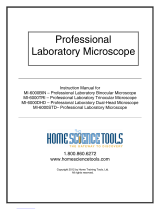
Microscope Set-up Guide
The Comprehensive Scope 2 compound microscope can be set up in a
matter of minutes. To get the most out of this amazing teaching tool,
follow these step-by-step instructions:
1. After unpacking the box, remove the Comprehensive
Scope 2 from the plastic bag and remove the protective
coverings from the objective lenses and the eyepiece(s).
2. Place the microscope on a flat, firm surface.
3. Check the coarse focus knob on either side of the main
body support. The coarse focus knobs should turn
easily.
NOTE: The stage should move freely up and down the main body
support when focusing. When you release the knob, the stage should
remain stationary, and not slide down the post on its own.
4. To operate the cordless feature of this microscope,
immediately plug in the microscope to charge for eight
(8) hours.
a. Plug in the round pin adapter from the power
supply to the back of your microscope.
b. Connect the opposite end to a Ken-A-Vision
multicharger (Part # SCGN061) or an 110V
(220V international) electrical outlet.
NOTE: With one eight (8) hour charge, you can use the microscope for
up to forty (40) hours of continuous operation. The cordless microscope
can also be operated with the cord plugged into a power source.
c. When not in use, plug the microscope into a
Ken-A-Vision multicharger that will automatically
stop charging once the microscope is fully
charged to keep it at the optimal full charge for
longer battery life. This prevents overcharging
and the user can charge up to eight (8)
microscopes at once.
d. Should you need a replacement power
supply/charger, or new specialized rechargeable
batteries (Part # VFBATBU5), contact your
nearest Ken-A-Vision dealer.
4













